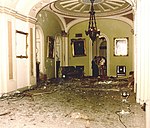On January 6, 2021, the United States Capitol Building in Washington, D.C., was attacked by a mob of supporters of then-U.S. president Donald Trump, two months after his defeat in the 2020 presidential election. They sought to keep Trump in power by preventing a joint session of Congress from counting the Electoral College votes to formalize the victory of President-elect Joe Biden. The attack was ultimately unsuccessful in preventing the election results from being certified. According to the House select committee that investigated the incident, the attack was the culmination of a seven-part plan by Trump to overturn the election.Within 36 hours of the event, five people had died: one was shot by Capitol Police, another died of a drug overdose, and three died of natural causes, including a police officer. Many people were injured, including 174 police officers. Four officers who responded to the attack died by suicide within seven months. As of July 7, 2022, monetary damages caused by attackers exceed $2.7 million.Called to action by Trump, thousands of his supporters gathered in Washington, D.C., on January 5 and 6 to support his false claim that the 2020 election had been "stolen by emboldened radical-left Democrats" and to demand that Vice President Mike Pence and Congress reject Biden's victory. Starting at noon on January 6, at a "Save America" rally on the Ellipse, Trump gave a speech in which he repeated false claims of election irregularities and said, "If you don't fight like hell, you're not going to have a country anymore." Thousands of attendees, some armed, walked to the Capitol, with hundreds breaching police perimeters as Congress was beginning the electoral vote count. Among the rioters were leaders of the Proud Boys and the Oath Keepers militia groups, who conspired to use violence to interfere with the peaceful transfer of power.More than 2,000 rioters entered the building, many of whom vandalized and looted parts of the building, including the offices of then House speaker Nancy Pelosi and other members of Congress. Rioters also assaulted Capitol Police officers and reporters, and attempted to locate lawmakers to capture and harm. A gallows was erected west of the Capitol, and some rioters chanted "Hang Mike Pence" after he rejected false claims by Trump and others that the vice president could overturn the election results.With building security breached, Capitol Police evacuated and locked down both chambers of Congress and several buildings in the Capitol Complex. Rioters occupied the empty Senate chamber while federal law enforcement officers defended the evacuated House floor. Pipe bombs were found at both the Democratic National Committee and Republican National Committee headquarters, and Molotov cocktails were discovered in a vehicle near the Capitol.Trump resisted sending the National Guard to quell the mob. Later that afternoon, in a Twitter video, he reasserted the inaccurate claim that the election was "fraudulent", and told his supporters to "go home in peace". The Capitol was clear of rioters by mid-evening, and the counting of the electoral votes resumed and was completed in the early morning hours of January 7. Pence declared President-elect Biden and Vice President-elect Kamala Harris victorious. Pressured by his cabinet, the threat of removal, and many resignations, Trump later committed to an orderly transition of power in a televised statement.A week after the attack, the House of Representatives impeached Trump for incitement of insurrection, making him the only U.S. president to have been impeached twice. In February, after Trump had left office, the Senate voted 57–43 in favor of conviction, short of the 67 votes needed, resulting in his acquittal. Republicans in the Senate blocked a bill to create a bipartisan independent commission to investigate the attack, so the House instead approved a select committee with seven Democrats and two Republicans to investigate. The committee held nine televised public hearings on the attack in 2022, voted to subpoena Trump, and ultimately, recommended to the Department of Justice (DOJ) that he be prosecuted. On August 1, 2023, following a special counsel investigation, Trump was indicted on four charges.More than 1,200 persons have been charged with federal crimes arising from the attack. As of December 2023, 728 defendants had pleaded guilty, while another 166 defendants had been convicted at trial; a total of 745 defendants have been sentenced. A significant number of participants in the attack were linked to far-right extremist groups or conspiratorial movements, including the Oath Keepers, Proud Boys, and Three Percenters. Numerous plotters were convicted of seditious conspiracy, including Oath Keepers and Proud Boys members; the longest sentence to date was given to then-Proud Boy chairman Enrique Tarrio, who was sentenced to 22 years' imprisonment.








